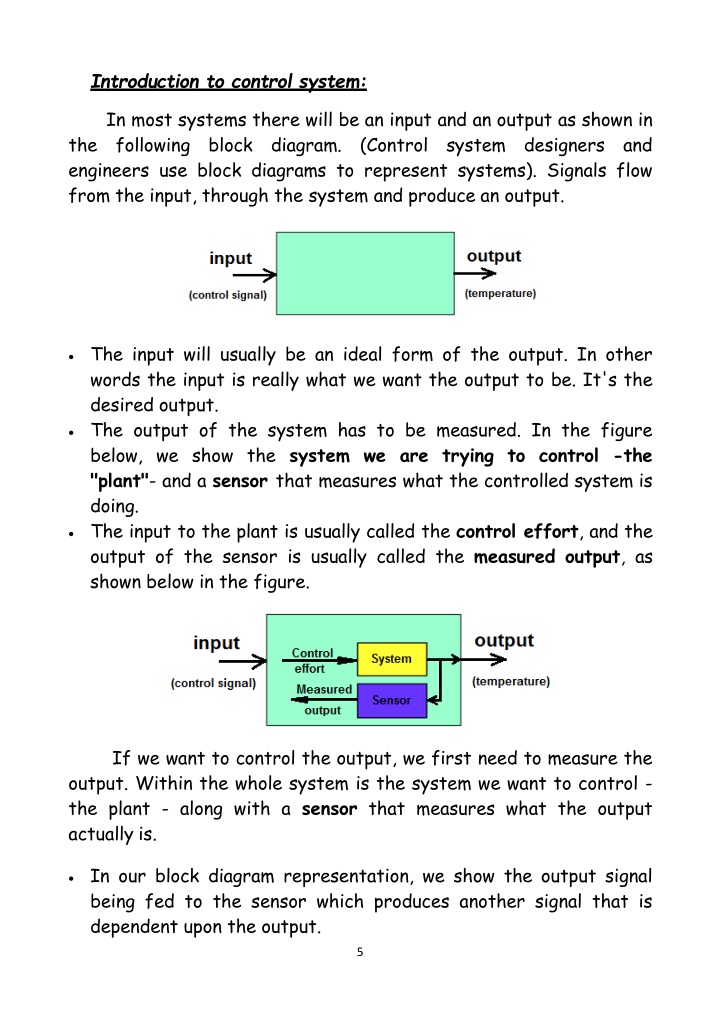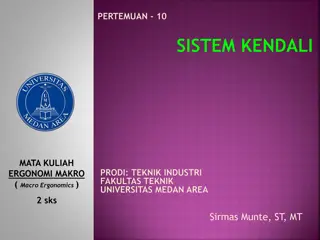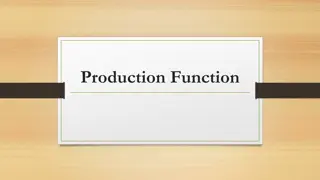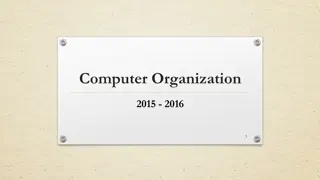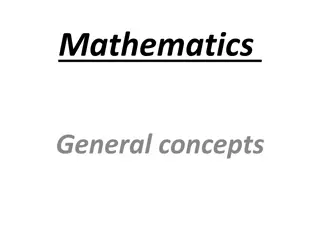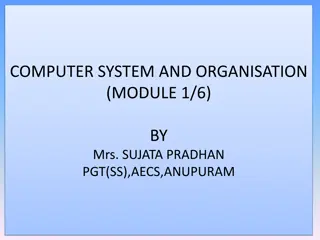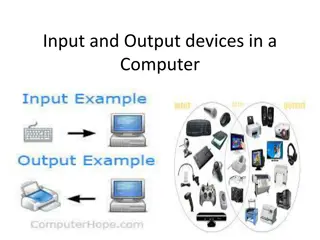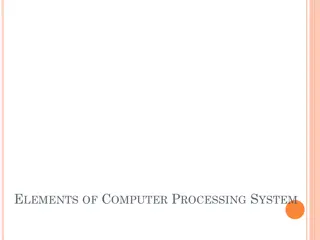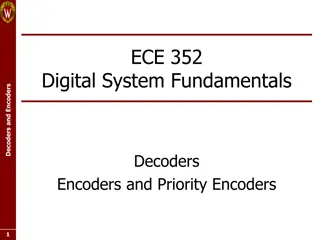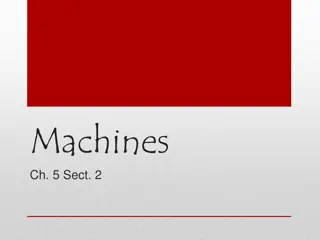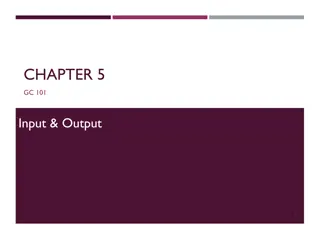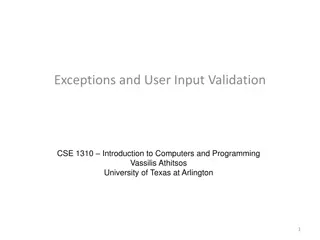Introduction to Control Systems: Understanding Input and Output Relationships
Control systems involve managing signals from input to output using sensors and controllers. Learn about open-loop and closed-loop systems, sensor usage, and types of control systems.
Download Presentation

Please find below an Image/Link to download the presentation.
The content on the website is provided AS IS for your information and personal use only. It may not be sold, licensed, or shared on other websites without obtaining consent from the author.If you encounter any issues during the download, it is possible that the publisher has removed the file from their server.
You are allowed to download the files provided on this website for personal or commercial use, subject to the condition that they are used lawfully. All files are the property of their respective owners.
The content on the website is provided AS IS for your information and personal use only. It may not be sold, licensed, or shared on other websites without obtaining consent from the author.
E N D
Presentation Transcript
Introduction to control system: In most systems there will be an input and an output as shown in following block diagram. (Control engineers use block diagrams to represent systems). Signals flow from the input, through the system and produce an output. the system designers and The input will usually be an ideal form of the output. In other words the input is really what we want the output to be. It's the desired output. The output of the system has to be measured. In the figure below, we show the system we are trying to control -the "plant"- and a sensor that measures what the controlled system is doing. The input to the plant is usually called the control effort, and the output of the sensor is usually called the measured output, as shown below in the figure. If we want to control the output, we first need to measure the output. Within the whole system is the system we want to control - the plant - along with a sensor that measures what the output actually is. In our block diagram representation, we show the output signal being fed to the sensor which produces another signal that is dependent upon the output. 5
A sensor, which produces a voltage proportional to temperature - if the output signal is a temperature. We need the sensor in the system to measure what the system is doing. To control the system we need to use the information provided by the sensor. Usually, the output, as measured by the sensor is subtracted from the input (which is the desired output) as shown below. That forms an error signal that the controller can use to control the plant. The device which performs the subtraction to compute the error, E, is a comparator. Finally, the last part of this system is the controller. Types of Control Systems: There are various types of control system but all of them are created to control outputs. The system used for controlling the position, velocity, acceleration, temperature, pressure, voltage and current etc. are examples of control systems. Let us take an example of simple temperature controller of the room, to clear the concept. Suppose there is a simple heating element, which is heated 6
up as long as the electric power supply is switched on. As long as the power supply switch of the heater is on the temperature of the room rises and after achieving the desired temperature of the room, the power supply is switched off. Again due to ambient temperature, the room temperature falls and then manually the heater element is switched on to achieve the desired room temperature again. In this way one can manually control the room temperature at desired level. This is an example of manual control system. This system can further be improved by using timer switching arrangement of the power supply where the supply to the heating element is switched on and off in a predetermined interval to achieve desired temperature level of the room. There is another improved way of controlling the temperature of the room. Here one sensor measures the difference between actual temperature and desired temperature. If there is any difference between them, the heating element functions to reduce the difference and when the difference becomes lower than a predetermined level, the heating elements stop functioning. Both forms of the system are automatic control system. In former one the input of the system is entirely independent of the output of the system. Temperature of the room (output) increases as long as the power supply switch is kept on. That means heating element produces heat as long as the power supply is kept on and final room temperature does not have any control to the input power supply of the system. This system is referred as open loop control system. But in the latter case, the heating elements of the system function, depending upon the temperature and desired temperature. This difference is called error of the system. This error signal is fed back to the system to control the input. As the input to output path and the error feedback path create a closed loop, this type of control system is referred as closed loop control system. Hence, there are two main types of control system. They are as follow Open loop control difference between, actual system and Closed loop control system. 7
Open Loop Control System: A control system in which the control action is totally independent of output of the system then it is called open loop control system. Manual control system is also an open loop control system. Fig - 1 shows the block diagram of open loop control system in which process output is totally independent of controller action. Practical Examples of Open Loop Control System: 1. Electric Hand Drier Hot air (output) comes out as long as you keep your hand under the machine, irrespective of how much your hand is dried. 2.Automatic Washing Machine This machine runs according to the pre-set time irrespective of washing is completed or not. 3.Bread Toaster - This machine runs as per adjusted time irrespective of toasting is completed or not. 4.Automatic Tea/Coffee Maker These machines also function for pre adjusted time only. 5.Timer Based Clothes Drier This machine dries wet clothes for pre adjusted time, it does not matter how much the clothes are dried. 6.Light Switch lamps glow whenever light switch is on irrespective of light is required or not. 7.Volume on Stereo System Volume is adjusted manually irrespective of output volume level. Advantages of Open Loop Control System: 1. Simple in construction and design. 2. Economical. 3. Easy to maintain. 4. Generally stable. 5. Convenient to use when output is difficult to measure. 8
Disadvantages of Open Loop Control System: 1. They are inaccurate. 2. They are unreliable. 3. Any change in output cannot be corrected automatically. Closed Loop Control System: Control system in which the output has an effect on the input quantity in such a manner that the input quantity will adjust itself based on the output generated is called closed loop control system. Open loop control system can be converted in to closed loop control system by providing a feedback. This feedback automatically makes the suitable changes in the output due to external disturbance. In this way closed loop control system is called automatic control system. Figure below shows the block diagram of closed loop control system in which feedback is taken from output and fed in to input. Practical Examples of Closed Loop Control System: 1. Automatic Electric Iron Heating elements are controlled by output temperature of the iron. 2. Servo Voltage Stabilizer Voltage controller operates depending upon output voltage of the system. 3. Water Level Controller Input water is controlled by water level of the reservoir. 4. Missile Launched & Auto Tracked by Radar The direction of missile is controlled by comparing the target and position of the missile. 5. An Air Conditioner An air conditioner functions depending upon the temperature of the room. 6. Cooling System in Car It operates depending upon the temperature which it controls. 9
Advantages of Closed Loop Control System: 1. Closed loop control systems are more accurate even in the presence of non-linearity. 2.Highly accurate as any error arising is corrected due to presence of feedback signal. 3. Bandwidth range is large. 4. Facilitates automation. 5.The sensitivity of system may be made small to make system more stable. 6. This system is less affected by noise. Disadvantages of Closed Loop Control System: 1. They are costlier. 2. They are complicated to design. 3. Required more maintenance. 4. Feedback leads to oscillatory response. 5. Overall gain is reduced due to presence of feedback. 6.Stability is the major problem and more care is needed to design a stable closed loop system. Comparison of Closed Loop and Open Loop Control System: No. Open loop control system Closed loop control system 1 The feedback element is absent. The feedback element is always present. 2 An error detector is not present. An error detector is always present. 3 It is stable one. It may become unstable. 4 Easy to construct. Complicated construction. 5 It is an economical. It is costly. 6 Having small bandwidth. Having large bandwidth. 7 It is inaccurate. It is accurate. 8 Less maintenance. More maintenance. 9 It is unreliable. It is reliable. 10 Examples: Hand drier, tea maker Examples: Servo voltage stabilizer, perspiration 10
Feedback Loop of Control System: A system that maintains a prescribed relationship between the output and the reference input by comparing them and using the difference as a means of control is called a feedback control system. So one signal is taken from output and is fed back to the input. This signal is compared with reference input and then error signal is generated. This error signal is applied to controller and output is corrected. Such a system is called feedback system. Figure below shows the block diagram of feedback system. When feedback signal is positive then system called positive feedback system. For positive feedback system, the error signal is the addition of reference input signal and feedback signal. When feedback signal is negative then system is called negative feedback system. For negative feedback system, the error signal is given by difference of reference input signal and feedback signal. Effect of Feedback: As can be seen in figure below, which represents feedback system where: R = Input signal, H = Feedback, C = Output signal, E = Error signal, G = forward path gain B = Feedback signal 11
1. Error between system input and system output is reduced. 2. System gain is reduced by a factor 1/(1 GH). 3. Improvement in sensitivity. 4. Stability may be affected. 5. Improve the speed of response. 12
